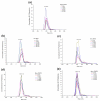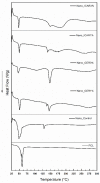Polymeric Nanorepellent Systems Containing Geraniol and Icaridin Aimed at Repelling Aedes aegypti
- PMID: 35955452
- PMCID: PMC9368950
- DOI: 10.3390/ijms23158317
Polymeric Nanorepellent Systems Containing Geraniol and Icaridin Aimed at Repelling Aedes aegypti
Abstract
Repellents are among the leading products used against diseases transmitted by the Aedes aegypti mosquito. However, their indiscriminate use or high concentrations can cause severe adverse reactions, particularly in children and pregnant women. To protect them, nanotechnology is a promising tool to encapsulate active compounds against degradation, increase their effectiveness, and decrease their toxicity, as it can promote the modified release of the active compound. This study aimed to develop polymeric nanocapsules containing the repellent actives geraniol and icaridin using low concentrations of the active component, with the objective of promoting effective activity and greater safety against adverse reactions. The nanocapsules were developed by the interfacial deposition method, and the physicochemical properties of the nanocapsules were evaluated using dynamic light scattering (DLS), nanoparticle tracking analysis (NTA), zeta potential, differential scanning calorimetry (DSC), Fourier transform infrared spectroscopy (FTIR), atomic force microscopy (AFM), release kinetics assay, and mathematical modeling. Cell viability was assessed by the MTT assay and genotoxicity analysis using the comet assay. The developed nanocapsules containing geraniol and icaridin showed mean diameters of 260 nm and 314 nm, respectively, with a polydispersity index < 0.2. The nanocapsules showed encapsulation efficiency values of 73.7 ± 0.1% for icaridin and 98.7 ± 0.1% for geraniol. Morphological analysis showed spherical nanocapsules with low polydispersity. The kinetic parameters calculated using the Korsmeyer−Peppas model indicated an anomalous release profile. Cell viability and genotoxicity analyses showed that the nanocapsules did not alter cell viability or damage DNA. The results demonstrate a promising nanostructured system with good physicochemical characteristics and good stability, with repellent activity against Aedes aegypti.
Keywords: Aedes aegypti; geraniol; icaridin; nanocapsules.
Conflict of interest statement
The authors declare no conflict of interest.
Figures













Similar articles
-
Cellulose Hydrogels Containing Geraniol and Icaridin Encapsulated in Zein Nanoparticles for Arbovirus Control.ACS Appl Bio Mater. 2022 Mar 21;5(3):1273-1283. doi: 10.1021/acsabm.1c01286. Epub 2022 Feb 15. ACS Appl Bio Mater. 2022. PMID: 35167254
-
Use of 2D and co-culture cell models to assess the toxicity of zein nanoparticles loading insect repellents icaridin and geraniol.Colloids Surf B Biointerfaces. 2022 Aug;216:112564. doi: 10.1016/j.colsurfb.2022.112564. Epub 2022 May 13. Colloids Surf B Biointerfaces. 2022. PMID: 35609505
-
Repellent active ingredients encapsulated in polymeric nanoparticles: potential alternative formulations to control arboviruses.J Nanobiotechnology. 2022 Dec 10;20(1):520. doi: 10.1186/s12951-022-01729-7. J Nanobiotechnology. 2022. PMID: 36496396 Free PMC article.
-
Trends in insect repellent formulations: A review.Int J Pharm. 2018 Mar 25;539(1-2):190-209. doi: 10.1016/j.ijpharm.2018.01.046. Epub 2018 Feb 3. Int J Pharm. 2018. PMID: 29410208 Review.
-
Efficacy and safety of repellents marketed in Brazil against bites from Aedes aegypti and Aedes albopictus: A systematic review.Travel Med Infect Dis. 2021 Nov-Dec;44:102179. doi: 10.1016/j.tmaid.2021.102179. Epub 2021 Oct 24. Travel Med Infect Dis. 2021. PMID: 34687870
Cited by
-
Biosynthesis and Biodegradation-Eco-Concept for Polymer Materials.Int J Mol Sci. 2024 Feb 26;25(5):2674. doi: 10.3390/ijms25052674. Int J Mol Sci. 2024. PMID: 38473920 Free PMC article.
-
Unlocking the therapeutic potential of Geraniol: an alternative perspective for metabolic disease management.Inflammopharmacology. 2024 Dec;32(6):3653-3668. doi: 10.1007/s10787-024-01582-0. Epub 2024 Oct 26. Inflammopharmacology. 2024. PMID: 39460887 Review.
-
Further Improvement Based on Traditional Nanocapsule Preparation Methods: A Review.Nanomaterials (Basel). 2023 Dec 12;13(24):3125. doi: 10.3390/nano13243125. Nanomaterials (Basel). 2023. PMID: 38133022 Free PMC article. Review.
-
Exploring the Potential of Nanotechnology in Pediatric Healthcare: Advances, Challenges, and Future Directions.Pharmaceutics. 2023 May 24;15(6):1583. doi: 10.3390/pharmaceutics15061583. Pharmaceutics. 2023. PMID: 37376032 Free PMC article. Review.
-
Design of Geraniol-Loaded Nanocapsules for Use Against Salmonella Infantis: Evaluation in an In Vitro Poultry Model.Pharmaceutics. 2025 Jun 27;17(7):840. doi: 10.3390/pharmaceutics17070840. Pharmaceutics. 2025. PMID: 40733049 Free PMC article.
References
-
- Brasil. Ministerio da Saude. Secretaria de vigilância em saúde Monitoramento dos casos de arboviroses urbanas causados por vírus transmitidos pelo mosquito Aedes (dengue, chikungunya e zika), semanas epidemiológicas 1 a 39, 2021. [(accessed on 10 April 2022)];Bol. Epidemiológico. 2021 52:1–10. Available online: https://www.gov.br/saude/pt-br/centrais-de-conteudo/publicacoes/boletins....
-
- Teich V., Arinelli R., Fahham L. Aedes aegypti e sociedade: O impacto econômico das arboviroses no Brasil. J. Bras. Econ. Saúde. 2017;9:267–276. doi: 10.21115/JBES.v9.n3.p267-76. - DOI
-
- World Health Organization (WHO) Dengue and Severe Dengue. 2022. [(accessed on 8 April 2022)]. Available online: https://www.who.int/news-room/fact-sheets/detail/dengue-and-severe-dengue.
-
- Zara A.L.D.S.A., Santos S.M.D., Fernandes-Oliveira E.S., Carvalho R.G., Coelho G.E. Estratégias de controle do Aedes aegypti: Uma revisão. Epidemiol. Serv. Saúde. 2016;25:1–2. - PubMed
-
- Qiu H., Jun H.W., McCall J.W. Pharmacokinetics, formulation, and safety of insect repellent N,N-diethyl-3-methylbenzamide (deet): A review. J. Am. Mosq. Control. Assoc. 1998;14:12–27. - PubMed
MeSH terms
Substances
Grants and funding
LinkOut - more resources
Full Text Sources
Miscellaneous

